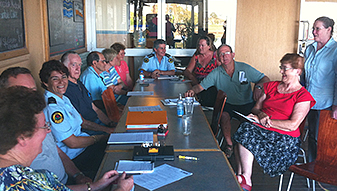Interpreting flood levels
Ways you may be informed
The NSW State Emergency Service (NSW SES) issues Flood Warnings to the media who then inform people about what is expected to happen during flooding. Radio stations are asked to read and repeat these Flood Warnings.
The NSW SES will also post information on flooding in the News section of the NSW SES website as well as on the NSW SES Facebook site. If you are a member of Facebook, please 'like' the NSW SES Facebook page to receive current flood information, updates and advice.
Other ways you may be informed of possible flooding is via:
- a door knock by emergency services,
- word of mouth, or
- the NSW SES may issue an Emergency Alert. An Emergency Alert is a message that is sent to your land line or mobile phone as a voice or text message
- TV, radio and other media
The NSW SES advises people to always follow instructions given by the emergency services and to make sure neighbours, family and friends are aware of possible flooding.
It is also important for people living in areas which are prone to flooding to be proactive in sourcing information about potential floods. Talk to your local Council about local information and what services will be available during floods, monitor the Bureau of Meteorology website and keep informed through other websites, the media and family and friends.
Interpreting flood levels
When the Bureau of Meteorology issue Flood Warnings they contain a predicted flood level. These levels indicate the estimated height of the floodwater.
Flood Levels
Minor flooding
Flooding which causes inconvenience such as closing of minor roads and the submergence of low-level bridges. The lower limit of this class of flooding is the initial flood level at which landholders and/or townspeople begin to be affected in a significant manner that requires the issuing of a public flood warning by the Australian Government Bureau of Meteorology.
Moderate flooding
Flooding which inundates low-lying areas, requiring removal of stock and/or evacuation of some houses. Main traffic routes may be flooded.
Major flooding
Flooding which causes inundation of extensive rural areas, with properties, villages and towns isolated and/or appreciable urban areas flooded.
Interpreting river heights
Flood Warnings may contain observed, peak or predicted river heights, these are often referenced from a flood gauge at a certain point along a river.
Predicted River Height
The height (in metres) to which the river is predicted to rise at the river gauge referred to in the warning. The actual depth of flood water will vary across the floodplain. Knowledge of past flood events, as well as estimates of flood levels from flood studies, are used by local Councils, emergency services and landowners to determine which areas are likely to be flooded from the predicted river height. The accuracy of this prediction will depend on a number of factors, including the type of flood forecasting model and its input data. Predicted river heights are subject to forecasting error and are regularly updated as more information becomes available.
Observed River Height
Depth of water (in metres) at a river height measuring gauge located along the river. In most cases, a zero reading is the lowest water level that is reached during dry conditions. In many tidal areas, as well as a few inland areas, river levels are expressed in metres above mean sea level or Australian Height Datum (AHD).
Peak River Height
Highest river height (in metres) observed during a flood event at the specified site on the river.



